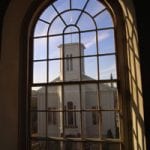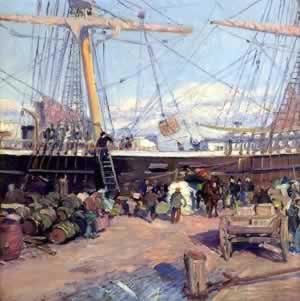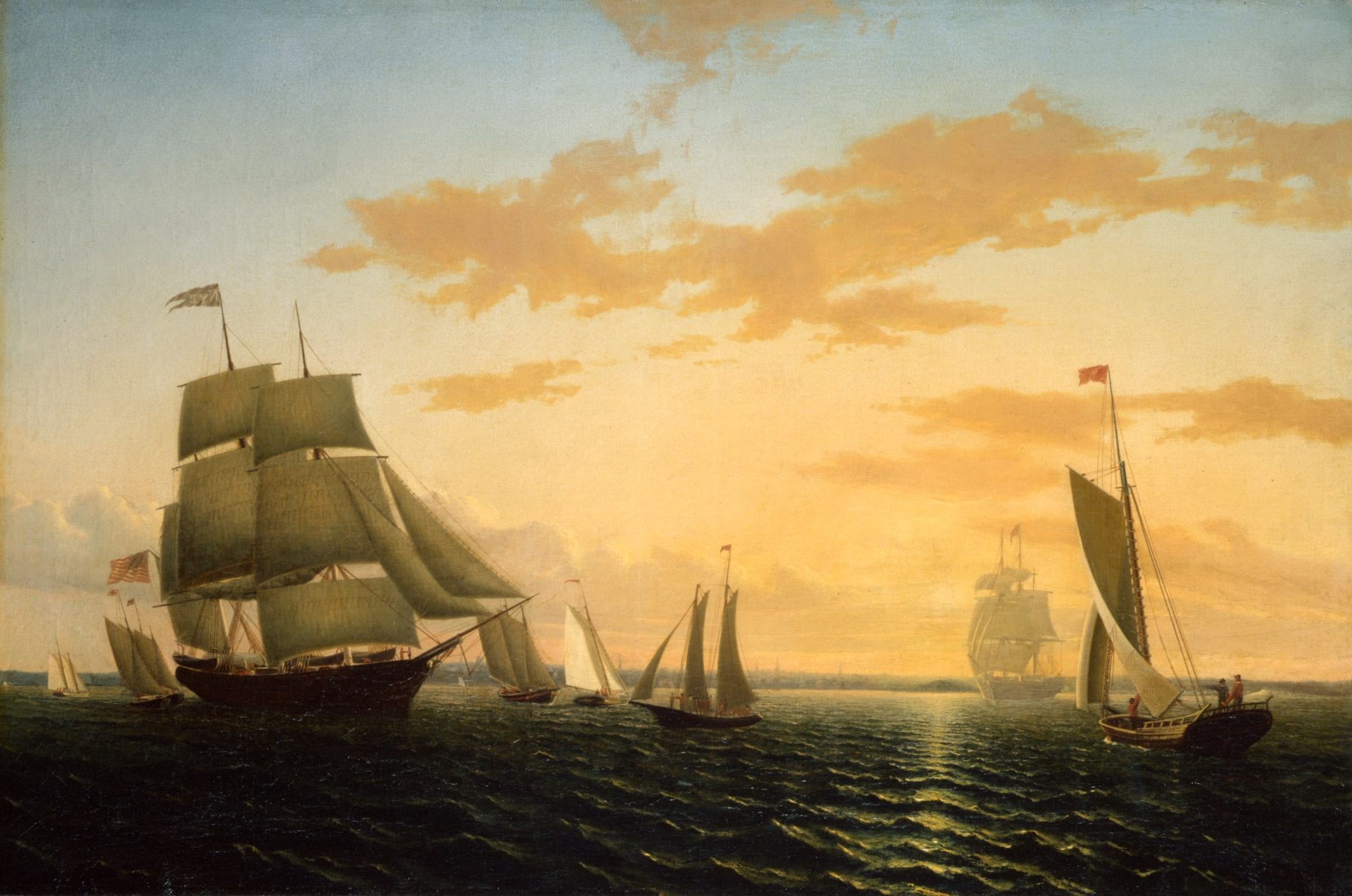New Bedford Artists
Melville’s New Bedford
“The dearest place to live in, in all New England”
A civilized town
When Herman Melville arrived in December 1840, New Bedford was at the height of its prosperity.
In his novel, Moby-Dick, Melville wrote that “. . . nowhere in all America will you find more patrician-like houses, parks and gardens more opulent, than in New Bedford. Whence came they?. . . Yes; all these brave houses and flowery gardens came from the Atlantic, Pacific, and Indian oceans. One and all, they were harpooned and dragged up hither from the bottom of the sea.”
A civilized town
When Herman Melville arrived in December 1840, New Bedford was at the height of its prosperity. In his novel, Moby-Dick, Melville wrote that “. . . nowhere in all America will you find more patrician-like houses, parks and gardens more opulent, than in New Bedford. Whence came they?. . . Yes; all these brave houses and flowery gardens came from the Atlantic, Pacific, and Indian oceans. One and all, they were harpooned and dragged up hither from the bottom of the sea.”
Whale profits for dowries
It was a city where a father might use profits from a whaling voyage for his daughter’s dowry and burn expensive spermaceti candles at her wedding. Long avenues were lined with mansions and magnificent elm trees. Near the waterfront, shipbuilders, bankers, brokers, merchants, blacksmiths, masons, oil refiners, and many other tradesmen connected with the whaling industry thrived.
“A cannibal on every corner”
The streets offered visitors frequent surprises. Melville wrote that, “. . . actual cannibals stand chatting at street corners; savages outright; many of whom yet carry on their bones unholy flesh.” Melville may have based the character of Queequeg, a harpooneer on the Pequod in Moby-Dick, on Pacific Islanders he saw in New Bedford. They often shipped out as hands on American whalers that stopped at their islands.
Whaleman’s chapel

Melville visited the Seamen’s Bethel before shipping out on the whaleship Acushnet in January 1841. When Ishmael, narrator of Moby-Dick, enters the chapel, he notices black-bordered marble tablets set into walls on either side of the pulpit. These cenotaphs are memorials to men who died at sea. “It needs scarcely to be told, with what feelings, on the eve of a Nantucket voyage, I regarded those marble tablets, and by the murky light of that darkened, doleful day read the fate of the whalemen who had gone before me. Yes, Ishmael, the same fate may be thine,” Melville’s narrator thought.
The Seamen's Bethel, as seen here from the New Bedford Whaling Museum, is across the street and open to visitors.
Artists and Artisans
Artists and artisans have been present in New Bedford since the eighteenth century, their work often reflecting changes in the life of a village that became America’s whaling capital.
From farmer artisans to fine furniture makers
In the colonial period, farmers in the New Bedford area were often part-time cabinet-makers. By the late eighteenth century, the whaling industry had produced a wealthy merchant class that could afford the items produced by full-time cabinet makers, clock makers, and chair makers, who began to advertise in the local newspaper around 1799.
Extraordinary mansions
Magnificent houses were built in New Bedford in the 1820s and 1830s, symbols of the profits reaped by whaling merchants. During the nineteenth century, over 200 craftsmen were involved in furniture-making in New Bedford and supplied furnishings for these great houses. They prospered along with their city and established a reputation for crafting furniture of exceptionally high quality.
From melodeons to tall-case clocks
Historical records demonstrate the variety of craftsmen active in the city during the golden age of whaling:
- Cabinet makers
- Chair makers
- Chest makers
- Clock and watch makers
- Gilders
- Gunsmiths
- Looking-glass and picture frame makers
- Melodeon manufacturers (the melodeon was a small reed organ)
- Polishers
- Upholsterers
Chests for the seafaring man
New Bedford craftsmen specialized in making seachests, which were typically 6-board pine chests. They were sold to thousands of men, who used them to carry their belongings on whaling voyages.
“The Cape Verde Packet" Oil on canvas by Clifford Warren Ashley.

A Haven for Painters
Some of America’s finest painters have lived and worked in New Bedford, especially during the last half of the nineteenth century:
Clifford Warren Ashley

(1881-1947), a New Bedford native, was an artist and writer. In 1904, he observed a whaling voyage aboard the Bark Sunbeam, which he wrote about for Harper’s Monthly Magazine and in his own book, The Yankee Whaler. As a painter, he recorded scenes on the islands of Buzzards Bay, on Cape Cod, and along the New Bedford waterfront.
Albert Bierstadt

(1830-1902), born in Germany, came to live in New Bedford when he was two years old. He became noted for vast canvasses of the American West. In later years, he also painted wild animals of North America.
William Bradford

(1823-1892), born in Fairhaven, painted portraits of whaling vessels in New Bedford harbor, before sketching and photographing in Labrador and the Arctic. He also painted the American landscape in places like the Sierra Nevada mountains and Yosemite.
Charles Henry Gifford

(1839-1904) was born and died in Fairhaven. Although his parents encouraged him to try carpentry and shoemaking, he eventually became a noted painter of marine scenes. At the age of twelve, he had been deeply influenced by seeing an exhibition of Albert Bierstadt’s paintings.
Robert Swain Gifford

(1840-1905), born on an island in Buzzards Bay, studied with Albert Van Beest (see below) and became a landscape painter and etcher. He traveled widely in Europe and Africa and enjoyed a long career as a teacher in the Cooper Union schools in New York.
Benjamin Russell

(1804-1885), served as a boatsteerer on a whaling vessel and painted whaling scenes and ship portraits when he returned home. He collaborated with Caleb Purrington on a Panorama of a Whaling Voyage ‘Round the World,’ which is now in the Museum’s collection, and also created landscapes and domestic scenes.
Learn more
Albert Pinkham Ryder

(1847-1917), born in New Bedford, was one of the most distinctive painters in the history of American art. An introspective man, his paintings came from inner visions rather than from the study of nature. He constantly reworked his oils, so that only 165 are known.
Clement Nye Swift

(1846 – 1918), born and died in the town of Acushnet, MA. He first aspired to be an animal painter and traveled abroad to study the style of French painters. His work met with critical acclaim and he exhibited in the famous Paris Salon from 1872-1881. He also wrote poetry – in particular, verses which were published in the New Bedford Standard on August 27, 1916, featuring “The Ship that Never Will Sail” in praise of the building of the Lagoda ship model at the Whaling Museum.
Dwight Tryon

(1849-1925), born in Hartford, Connecticut, summered in South Dartmouth and was associated with the Tonalist and Quietist schools of painting. He created landscapes that are lyrical and subtle.
Albert Van Beest

(1820-1860), born in Holland, spent three years collaborating with William Bradford (see above). A talented marine artist, Van Beest was particularly skilled at capturing the drama of shipwrecks and storms at sea.
William Allen Wall


(1801-1885), who was born and died in New Bedford, came from a Quaker family. After trying his hand at clockmaking and watchmaking, he studied painting in Europe and returned to New Bedford to do portraits, landscapes, and historical subjects, producing a rich pictorial history of his native city.


